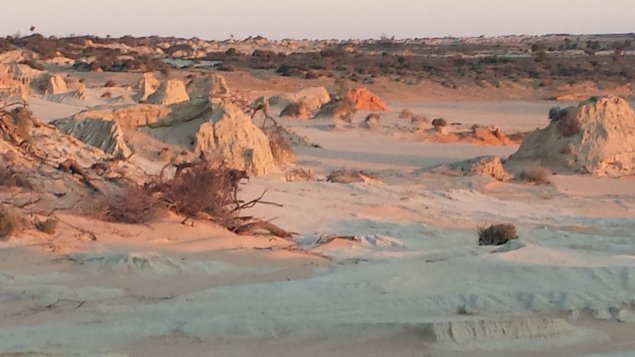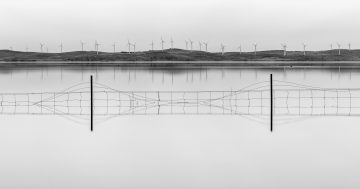
Ever been to Lake Mungo, down from Broken Hill and up from Mildura? Climbed the dunes at the Walls of China on the lunette? If you have you will have come away affected for the rest of your days.
I went there on my Broken Hill trek recently and was blown away.
For those unfortunate never to have been there, Lake Mungo is a dry lake in north-west NSW, and it has a lunette (half-moon) of dunes which have been caused by soil erosion over thousands of years, exacerbated since the 1800s by vegetation depletion from sheep and goat grazing and rabbit plagues. The denuding of the vegetation left the soil vulnerable to shifting and the piled up at what is called the Walls of China.
This erosion and soil shifting (actually it is sand of the beach variety) has uncovered evidence of human habitation dating back 20,000 to 30,000 years.
This is the place where the skull of Mungo Lady and the skeleton of Mungo Man were discovered. This is the reason it is part of the World Heritage listed Willandra Lakes Region. Many more human remains have been found but they have been left in situ and re-covered to ensure their preservation.
I saw evidence of fireplaces dated by carbon dating which were 20,000 years old. I saw skeletal remains of a Tasmanian Devil, giant wombats and other animals since extinct.
Standing on the dunes, on freshly combed sand from the winds of the night before, I saw the immensity of this spectacular site and experienced a real time feeling of my own insignificance.
The talks by the two guides we had showed a connection with the area by the original walkers on the land and how they revered their environment. They only took what they needed to fill their families. The fished the lake, hunted the mussels, kangaroos and emus and buried their dead with dignity and ceremony.
Who would have thought that a people 20,000 years ago would have societal morays and paradigms? Who would have thought that these “primitive” people had a defined society? We have been taught that the indigenous people didn’t have that structure all those years ago. So much for that theory!
And BTW, Wikipedia has some pretty accurate stuff on Lake Mungo if you want to read it.
I was left with an enormous sense of awe.
But… and there is always a but, eh? The National Parks people and the NSW Parks and Wildlife people should really get their act together.
Let’s go to the smaller of my two gripes. The Lake Mungo Visitors Centre is a small museum with a couple of interesting exhibits, but is un-staffed 90% of the time. There is nothing for sale, like a bottle of water for those who forgot, no take away paraphernalia, and the guides only turn up just prior to the scheduled tour, which you find out about in Mildura or Balranald.
The amenities, toilet blocks and showers are clean and in good nick, which is helpful for the handful of campers in their RVs or self-contained shacks. The phone on the wall has been out for months and there is no mobile coverage. Too bad if you break down!
The guides on the other hand were fantastic. Their local knowledge and stories were enthralling and their knowledge of the archaeology of the area more than adequate.
But… the guides are casual, not part time or full time guides. We met Ernest, a local indigenous man, who gave us the history, the archaeology, the “stories” and the entertainment which was so in sync with the place. I learnt heaps from this man who was largely uneducated in formal terms but carried a wealth of knowledge dwarfing mine.
Not only was Ernest a talented and knowledgeable guide, he also earnt occasional money mustering goats for a local concern who trade in goat skins and meat from feral and semi-feral goats. He also does occasional work on properties nearby. And… he does weed and rabbit control for the National Parks people.
What an exploitation of his talents! The Lake Mungo area is always in need on constant care and whilst there are some maintenance people on site, there should be a program of permanent and fulltime work for the indigenous people of the area who look after the land and are happy to share their stories. Ernest should have been a full time guide who was on the payroll to look after his heritage and this unreal place.
What a way to dispel some of the misinformation about our first citizens? Not!
I came away thinking that the authorities weren’t doing enough for these folk, enough about their prospects and about their quality of life.
I came away with a sense of anger.
All in all, though I’m so glad I went. Blew my mind. How about any of you?





















